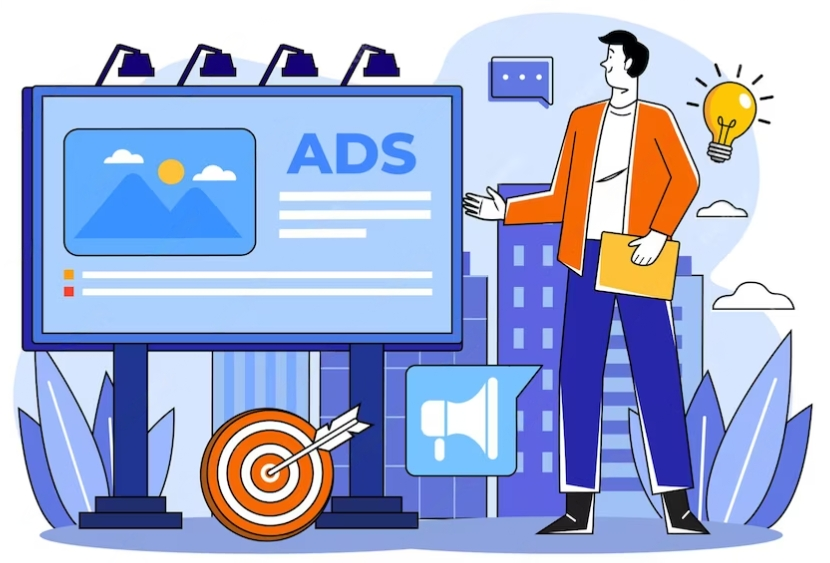Maximizing ROI: Top Display Ad Networks You Need to Know
Recently updated: November 6th, 2023
Display ads are the second most popular digital advertising format in the United States after search advertising. Display advertising accounts for over 30 percent of digital ad spending. It is popular across various industries, such as retail, travel, entertainment, and more.
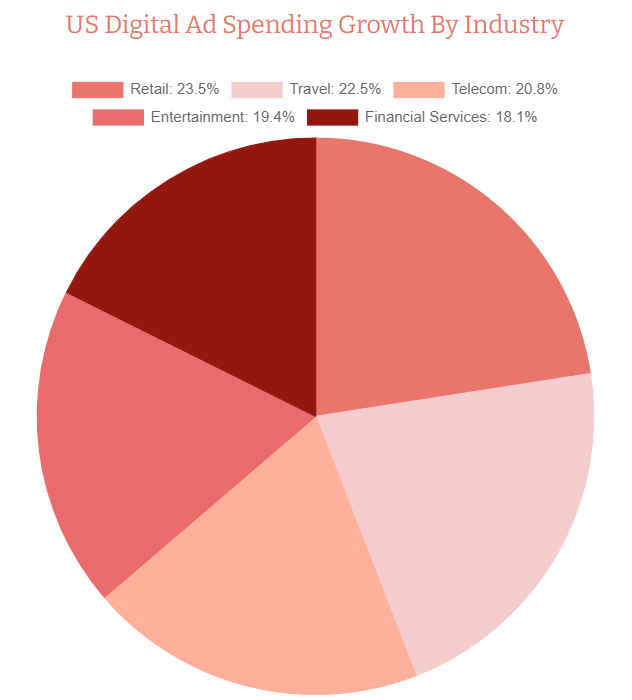
Source: MarketSplash
Did you know?
- 63.66% of display ads have animated designs (Source: MarketSplash)
- Over $58 billion was invested in banner ads in 2022 (Source: Statista)
- With 90% of internet users, Google owns the largest display ad networks. (Think with Google)
- 12% of total website traffic comes from display ads (Source: MarketSplash)
Most businesses expect at least a 200% return on their ad investment. However, the ROI of digital ads varies from one industry to another. For instance, e-commerce businesses often aim for ROIs of over 500%. At the same time, companies in other highly competitive industries may feel satisfied with a %100 ROI.
Besides, more businesses in the United States plan to increase their digital display ad spend.
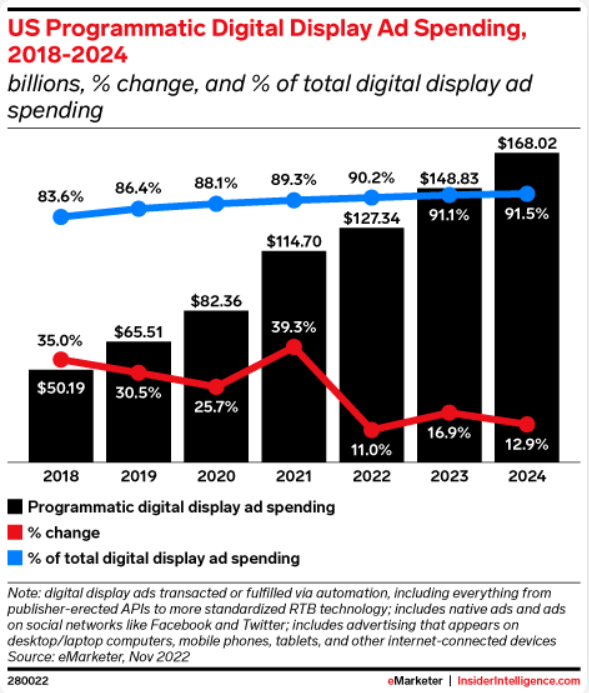
Source: eMarketer
If you are also planning to invest in display ads, knowing the top display ad networks is a must to maximize your ROI on digital ad spend.
What Is a Display Ad Network?
A display ad network is a platform that connects advertisers to website publishers with ad space to fill. It enables businesses to easily manage ad campaigns by compiling available ad inventory into one central marketplace.
Publishers can tap into this ad network to monetize their sites by displaying high-quality, targeted ads. The ad network matches relevant ads to the publisher’s audience and content, ensuring businesses reach their ideal customers.
This system provides advertisers access to a vast network of sites to get their ads in front of the right audience.
With Search Network, advertisers target keywords to grab attention. However, with Display Network, advertisers target audiences, interests, and websites to gain brand exposure and fulfil advertising goals.
Is Ad Network different from Ad Exchange?
While ad networks and ad exchanges deal with online advertising inventory, they serve different roles in connecting publishers and advertisers.
Ad Networks vs. Ad Exchanges
Ad Networks
- An ad network acts as a centralized platform to match publishers with ad space on their sites with advertisers looking to promote their products or services.
- Ad networks allow advertisers to purchase ad impressions in bulk bundles privately negotiated between the network and the advertiser.
- This bundled inventory model makes ad buying simpler for advertisers.
- Advertisers have less control over targeting specific sites or pages.
Ad Exchanges
- Ad exchanges operate more like a stock exchange, facilitating the real-time buying and selling of digital ad impressions through an automated bidding system.
- Rather than buying set bundles, advertisers can bid on individual impressions targeted to their ideal audience, websites, placement, etc.
- It is an open marketplace where supply and demand determine the value of inventory.
- Publishers get a better yield by selling to the highest bidder, while advertisers only pay for the impressions they want.
| Ad Networks | Ad Exchanges |
|---|---|
| Allow advertisers to connect with publishers | An online marketplace for ad inventory |
| Private advertisement dealing | Operate via open auctions |
| Can buy bulk ad impressions | Bid on impressions |
| Predefined value | Inventory value depends on demand and supply |
Ad networks offer bundled package deals for a more hands-off approach. Ad exchanges provide impression-level targeting, transparency, and control through real-time bidding.
Ad networks keep deals private, while exchanges operate via open auctions. Both serve a role in making the buying and selling of online advertising more efficient at scale.
The model that works best depends on the advertiser’s goals, budget, and desire for transparency.
How Do Ad Networks Work?
Publishers install ad network code on their websites and apps to access the network’s advertisers. It allows them to earn money through their ad inventory.
Advertisers select ad network(s) to run campaigns on. They set up campaigns in the network interface, defining:
- Budget
- Target audience
- Ad frequency caps and other parameters
The ad network uses advanced algorithms to match the most suitable publishers to each ad campaign based on:
- The advertiser’s specified targeting
- Optimization for campaign goals
- Publisher audience, content, and other factors
When a user visits a publisher’s site, the ad network serves the most relevant ad to that user in real time. The advertiser’s ad is displayed on the publisher’s site. The publisher earns revenue from the ad network if the user engages with the ad.
Through this automated process, ad networks connect targeted ads to the best publishers to help advertisers reach their ideal audiences efficiently. Publishers monetize their sites through relevant, high-quality ads.
How Do Ad Networks Benefit Publishers and Advertisers?
Benefits of Ad Networks for Publishers:
- Increased ad revenue – Monetize website traffic by filling unsold ad inventory through the network
- Targeted ads – Receive more relevant, high-quality ads aligned to your content
- Time savings – Ad network manages ad placements and campaign optimization
- Broader reach – Access more advertisers and demand through the network platform
Benefits of Ad Networks for Advertisers:
- Expanded reach – Get your ads in front of more targeted audiences across a wider network of sites
- Improved targeting – Leverage advanced network algorithms to identify the best placements
- Efficiency – Eliminate the need to negotiate individual deals with publishers manually
- Reporting – Gain insights into campaign performance through network analytics
- Brand safety – Ad network vets publisher sites for quality assurance
- Cost savings – Buying inventory at scale through the network lowers CPMs
Both publishers and advertisers benefit by tapping into the targeting capabilities, reach, and efficiency of ad networks.
Different Categories of Display Advertising
Display advertising offers a variety of targeting methods to help advertisers reach their ideal audiences. Some key categories include:
Site Placement
Place ads on specific websites frequented by the target demographic. For example, ads on automotive sites for a car brand.
Keyword Contextual Targeting
Match ads to pages containing relevant keywords. Ads for software are shown on pages about “software downloads”.
Contextual Targeting
Serve ads relevant to page content, without keywords. For instance, fitness ads on a health content site.
Retargeting/Remarketing
Includes targeting ads to users who previously visited your website or took an action like abandoning a cart and following them around the web.
Placement Targeting
Allows advertisers to define specific sites, pages, or apps to run ads on and places ads only in selected ad inventory.
Targeting In-Marketing Audiences
Serve ads to users already exposed to other touch-points of a marketing campaign.
Affinity Audiences (Interest-Based)
Targeting users based on their interests, hobbies, and lifestyle. For example, ads for runners on sports sites
Audience Targeting
Uses parameters like demographics, location, behavior, and intent data to target ads.
Layered Targeting
Combine multiple targeting tactics for highly specific targeting. Like placements + remarketing. With precise targeting, advertisers can ensure their ads reach engaged users open to their messaging.
Different Formats of Display Advertising
Display ads come in a variety of formats, each with its own advantages. Common options for display ads include:
Banner Ads
- Banner ads are static, graphical ad units
- Served in standard IAB sizes like 728×90 leaderboard or 300×250 rectangles
- Simple and inexpensive to create
- Limited engagement potential
- Best for brand awareness
Pop-up Ads
- Display in new browser windows over website content.
- High visibility but can annoy users
- Helpful for promotions or lead generation
- Blockers limit effectiveness
Pop-under Ads
- Similar to pop-ups but open behind the current browser window
- Less intrusive
- Visitors may never see the ad, but still drives awareness
Layer Ads
- Ads that float over page content without blocking it.
- Gain attention while allowing users to continue browsing.
- These ads can disrupt reading.
Content Ads
It is advertorial content promoting a brand, product, or service in a native ad format blended into surrounding editorial content.
- It appears less like an ad but requires content creation.
Google Display Ads
- Highly visible, spacious ad formats are offered through the Google Display Network.
- Options like Lightbox and Pushdown have extra engagement and branding capabilities.
Social Media Display Ads
- Ads placed in social media feeds and pages.
- Native placement captures attention where users are already active and engaged.
- These ads are shown to large built-in targeted audiences.
Other Options:
- Video ads – Engaging sight, sound, and motion
- Mobile ads – On apps and mobile sites
- Rich media – Animation, flash, and interactive elements
With a mix of formats, advertisers can achieve multiple campaign objectives, from building brand awareness to generating clicks and conversions across platforms. The ideal display ad formats depend on goals, placement, and budget. Testing different options is the key to determining what resonates best with your audience.
How to Choose the Best Display Ad Network
You must choose the right display ad networks to reach the right audience and make the most of your display ad investment. Here are a few tips to help you select the best display ad network:
Define Your Display Advertising Goals
You must ensure to match your objectives to the network’s strengths. Clearly outline what you want to achieve from display advertising before evaluating networks. Common goals include:
- Increasing brand awareness
- Generating more website traffic
- Capturing leads
- Boosting conversions
Identify the Right Audience for Your Display Ads
Determine the demographics, interests, and online behaviors to reach the right target audience. Look for ad networks with robust targeting capabilities tailored to your audience profile. Reaching the right users is critical for effective campaigns.
Ad Network Reputation
Research ad network reputation before you partner with it. Established ad networks with years in business tend to be more trustworthy. Look for ones servicing reputable brands in your industry. Positive word-of-mouth indicates satisfied advertisers.
Size and Reach of the Ad Network
Bigger ad networks offer wider reach through their expansive publisher base. But niche, vertical networks may better cater to your specialized target market. Evaluate which display ad network best aligns with your goals and ideal audience. Also, consider the quality and brand safety of network sites.
Available Ad Formats and Creative Options
Assess ad formats like banners, native ads, animation, video, and rich media offered by the network. More creative ad options allow for greater engagement. Ensure the network supports the types of ads you want to run.
Most Popular Design Types of Display Ads:
- Animated: 63.66%
- Static: 35.02%
- Audio and Video: 1.32%
Ad Targeting and Optimization Features
Look for advanced targeting based on demographics, location, interests, browsing behavior, and more. Optimization features like real-time bidding increase relevancy. These data-driven options improve campaign performance.
Reports and Analytics
Robust reporting and analytics help monitor campaign KPIs and optimize for better results. The display ad network should provide actionable insights through customizable dashboards and tools.
Analyze Pricing Models and Costs
Review the network’s rate models like CPM, CPC, and CPA to assess potential costs. Compare to other networks and expected ROI. Consider minimum ad budget, transparency, hidden fees, and alignment with your budget.
Billing Models Available for Display Advertising
Display advertising networks offer a wide range of pricing models, depending on the purpose of display ads. The most common billing models are as follows:
Cost per Mille (CPM)
- An advertiser pays for every 1,000 ad impressions shown
- Based on the number of impressions rather than clicks/conversions
- Good for brand awareness campaigns focused on reach
Cost per Click (CPC)
- Advertiser is charged each time ad is clicked
- Focuses payment on user engagement vs. impressions
- A popular model for ads aimed at driving traffic
Cost per Action (CPA)
- An advertiser pays only when a desired action occurs (sign-up, purchase, etc.)
- Risk shifts to network to deliver conversions
- Used for performance marketing goals
Cost per Install (CPI)
- Common in mobile app advertising
- An advertiser pays when a user installs the mobile app from an ad
- Maximizes the number of app installs
Cost per View (CPV)
- Charges advertiser for a video ad view of a certain length/duration
- Used in video and rich media ad formats
- Prices can vary based on video length
Cost per Sale (CPS)
- Advertiser pays network only after a sale
- Aligns costs closely to sales revenue
Revenue Sharing
- A publisher receives a percentage of the ad revenue from impressions
- Allows flexible monetization for publishers
Top 10 Display Ad Networks Every Marketer Must Know
1. Google Display Network
Payment Model: CPC, CPM, and more
Minimum Traffic: Not applicable
The Google Display Network (GDN) is the world’s largest display ad network, delivering over 1 trillion ad impressions monthly to over 1 billion global users. GDN provides expansive reach through publisher sites, videos, and apps to engage audiences everywhere across devices.
Google Display Network consists of different Google Properties, such as YouTube, Google Finance, Gmail, and others that offer display advertising and a network of millions of partner sites and apps to run display ads.
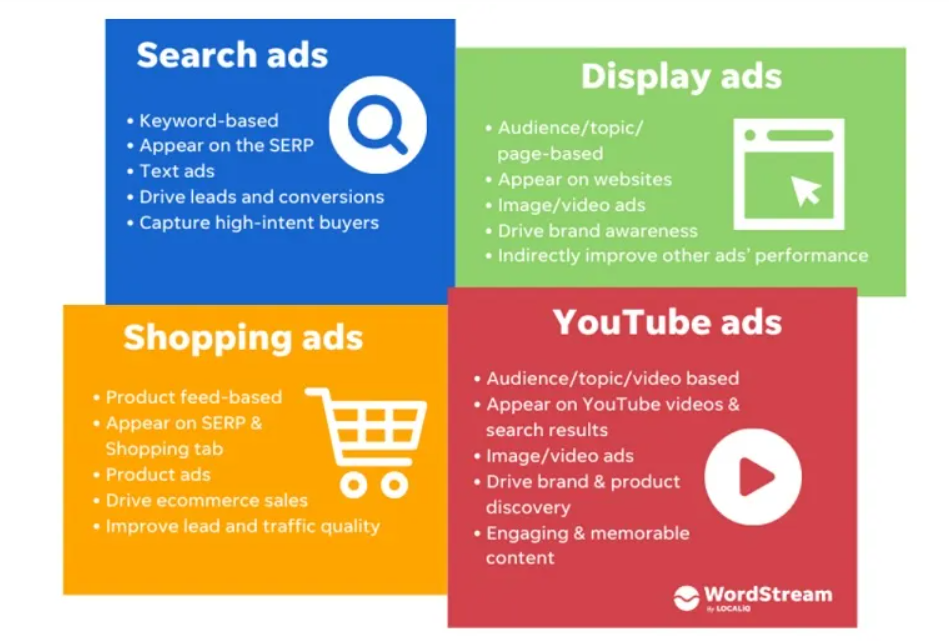
Source: WordStream
Advanced targeting and diverse ad formats allow advertisers to connect with their best customers when and where it matters most.
Key features of the Google Display Network include:
- Massive reach – Over 90% internet user coverage globally
- Cross-device targeting – Ads across mobile, tablet, and desktop
- Flexible ad formats – Options like native, video, and banner ads
- Powerful targeting – Contextual, demographic, interest, and placement targeting
- Optimization tools – Automated bidding and performance optimization
- Global scale – 135+ countries with local expertise
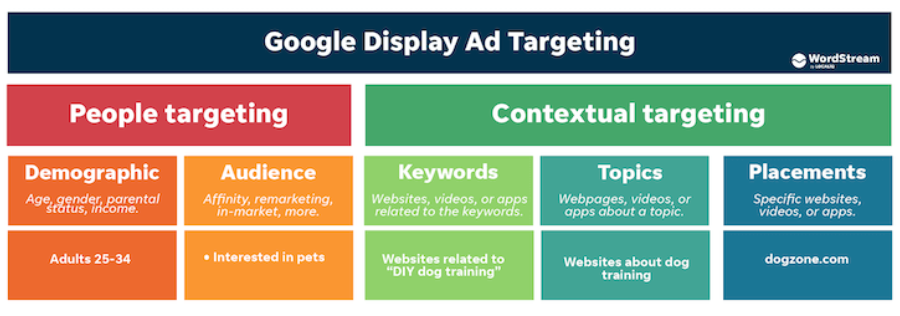
Source: WordStream
With its unmatched scale, advanced targeting, and optimization capabilities, the Google Display Network helps advertisers achieve their awareness, consideration, and conversion goals.
2. Amazon Advertising
Payment Model: CPC, CPM, CPA, and Dynamic Bidding
Minimum Traffic: Vary based on product category, targeting options, and competition
Amazon offers robust advertising solutions to help brands promote products and engage shoppers on and off its marketplace. Two main Amazon Display Advertising options include:
Sponsored Display
Self-serve display ads on Amazon leveraging familiar elements like product images, ratings, and Prime badges.
- Reach shoppers browsing related products or categories
- Options to target custom audiences and remarket
- Integrates with other Amazon ads
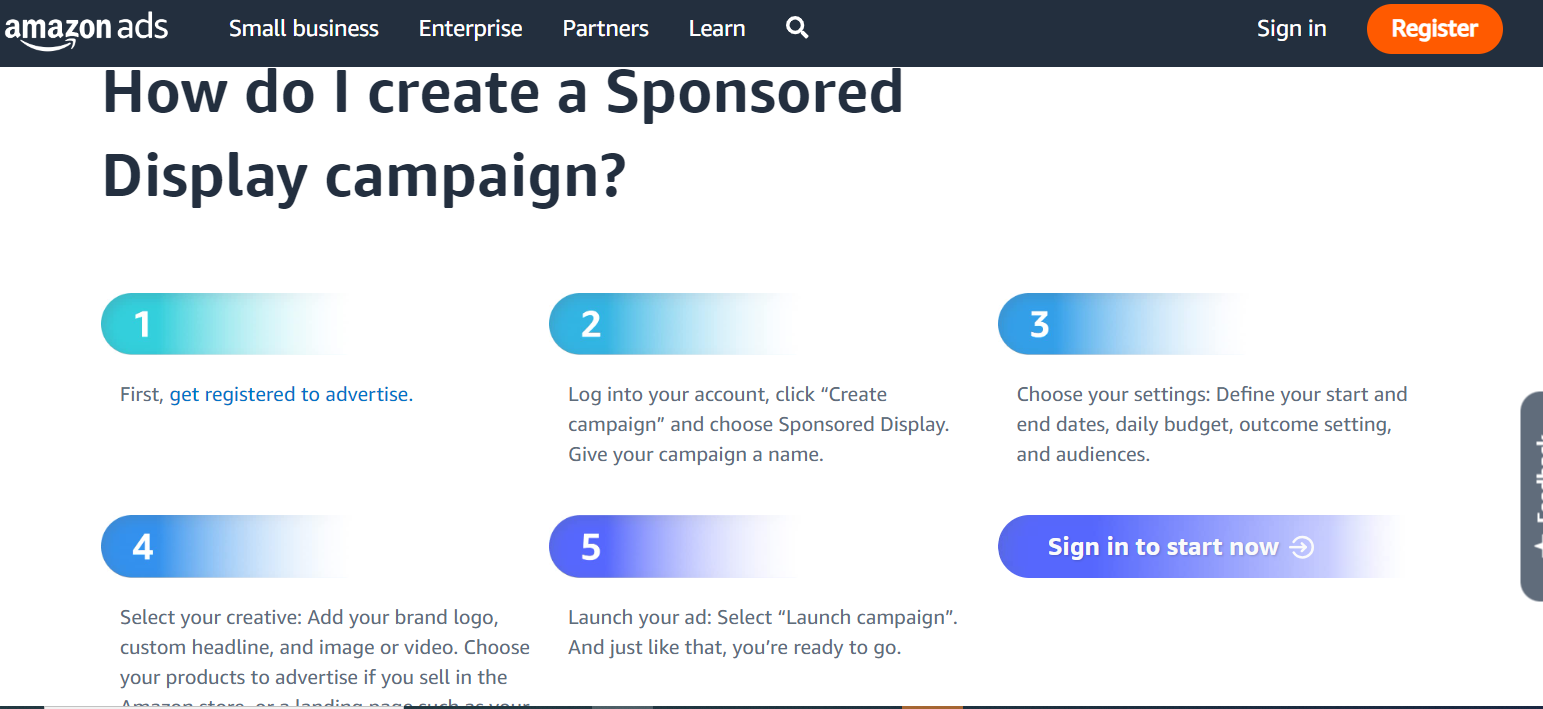
Amazon DSP
It is a demand-side platform for programmatic display, video, and audio ad buying on and off Amazon. Amazon advertisers can benefit from:
Audience targeting:
- Leverage Amazon’s data to build custom & lookalike audiences
- Demographic, interest, shopping behavior targeting
Placement targeting:
- Amazon sites, apps, publishers
- Third-party exchanges
Performance analytics:
- Robust insights on audience reach and engagement
- Viewability metrics, cost per conversion data
- Assess campaign effectiveness
Together, Sponsored Display and Amazon DSP offer ways to connect with shoppers throughout the buyer journey – from awareness to consideration to purchase. Advertisers can drive brand visibility and engage consumers both on Amazon as they search and browse and off Amazon through targeted prospecting. The combination provides scale, intelligence-based targeting, and measurable results.
3. Meta Audience Network (formerly called Facebook Audience Network)
Payment Model: CPC, CPM, and CPA
Minimum Traffic: Not applicable
The Meta Audience Network lets advertisers extend their campaigns beyond Facebook to partner websites, apps, and OTT platforms. Based on a study conducted on Facebook ad campaigns, people who see ads across different platforms such as Facebook, Messenger, Audience Network, and Instagram are 8 times more likely to convert than people who see ads only on Facebook.
Massive Reach: Over 1 billion Facebook users plus additional partner inventory
Types of Display Advertising:
- Native ads – Blend organically with the platform’s content
- Banner ads – Can appear anywhere on the app
- Interstitial ads – Offer a fully immersive experience for Meta Audience Network users
- Rewarded video ads – Are great for gamer audience and provides a player-initiated, player-friendly, and seamless ad experience in exchange for an in-app benefit
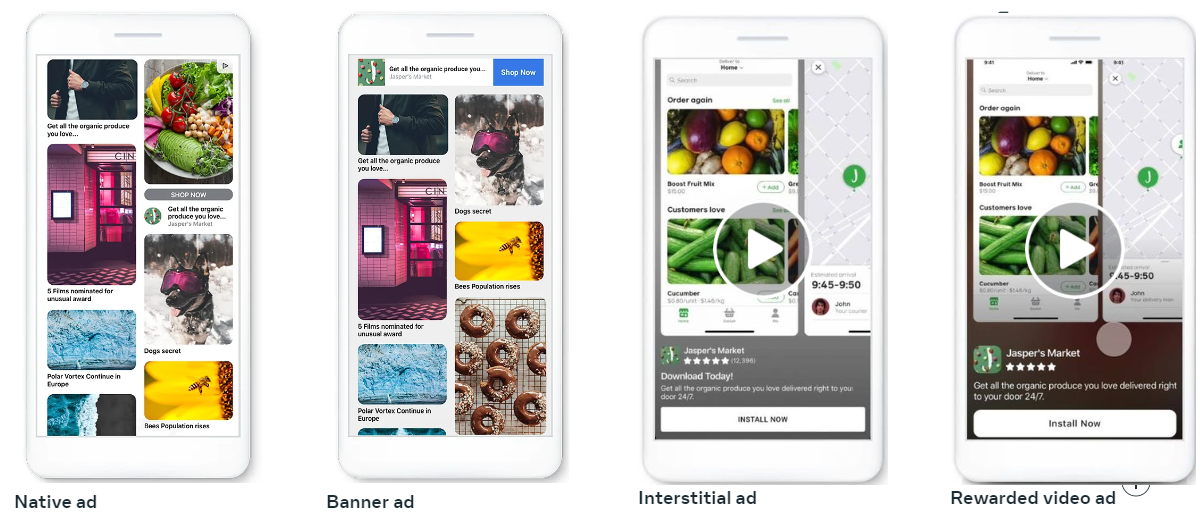
Source: Facebook
Display Ad Formats:
- Image ads
- Video ads
- Stories ads
- Messenger Ads
- Carousel Ads
- Slideshow Ads
- Collection Ads
- Playables
Facebook ads allow you to filter target audiences based on interests, such as food, lifestyle, shopping, entertainment, etc. You can create goals like Boost Post, Get More Website Visitors, and Get More Messages.
Some Key Things to Know About Meta Audience Network
- Targeting: Leverage Facebook’s powerful demographic, interest, behavioral, and lookalike audience targeting
- Cross-Platform: Ability to reach users across devices (mobile, desktop, tablet)
- Seamless Integration: Easily launch campaigns using existing Facebook ad accounts
- Measurement: Robust campaign analytics and reporting through Facebook
- Brand Safety: Facebook screens all network publishers and inventory
Benefits for Facebook Network Advertisers:
- Expanded reach beyond Facebook users alone
- Retarget people who have engaged with your Facebook ads
- Powerful built-in audience targeting capabilities
- Cross-device and cross-platform omnichannel approach
- Familiar, easy-to-use Facebook Ads interface
With unmatched targeting scale and seamless integration with Facebook ad campaigns, the Facebook Audience Network is a compelling option for display advertising.
4. Microsoft Advertising
Payment Model: CPC, CPM, CPA, and Dynamic Bidding
Minimum Traffic Req.: Vary based on targeting options, industry, etc.
Microsoft Advertising offers display, native, mobile, and video ad solutions to help brands connect with target audiences globally.
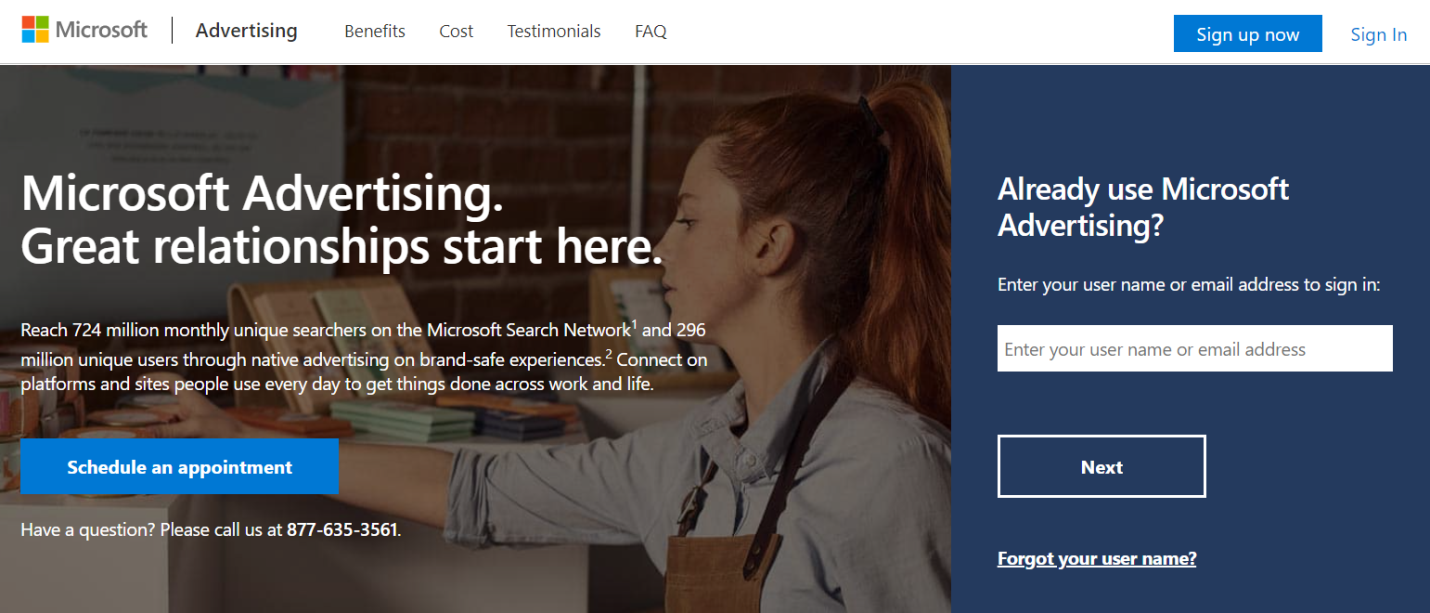
Source: Microsoft
Scale and Reach:
- 50+ markets, 30+ languages
- Microsoft properties like MSN, Outlook, Xbox, and Microsoft Casual Games
- 425+ million monthly unique visitors across Microsoft sites
Premium Ad Inventory:
- High viewability rates in a brand-safe environment
- Native ads on Outlook.com perform exceptionally well
Flexible Buying:
- Programmatic marketplace and direct deals available
- No minimum spend required
- Pay only for clicks
Multi-Channel Options:
- Display, native, mobile, and video ad formats
- Omnichannel approach across Microsoft properties
- Engaged Xbox audience and large Outlook commercial inbox
Targeting Capabilities:
- Leverage Microsoft first-party data for audience targeting
- Contextual and geographic targeting
- Retarget website visitors
Seamless Integration:
- Easily import existing Google/Facebook campaigns
- Robust analytics and reporting
With unmatched reach through Microsoft’s global properties, powerful targeting capabilities, and flexible buying options, Microsoft Advertising provides a compelling platform for brands to engage relevant audiences programmatically across devices and formats. The ability to tap into Microsoft’s owned-and-operated inventory gives advertisers a major advantage.
5. BidVertiser
Payment Model:
Minimum Traffic: Not applicable
BidVertiser is a global display ad network serving over 80,000 publishers and advertisers worldwide.
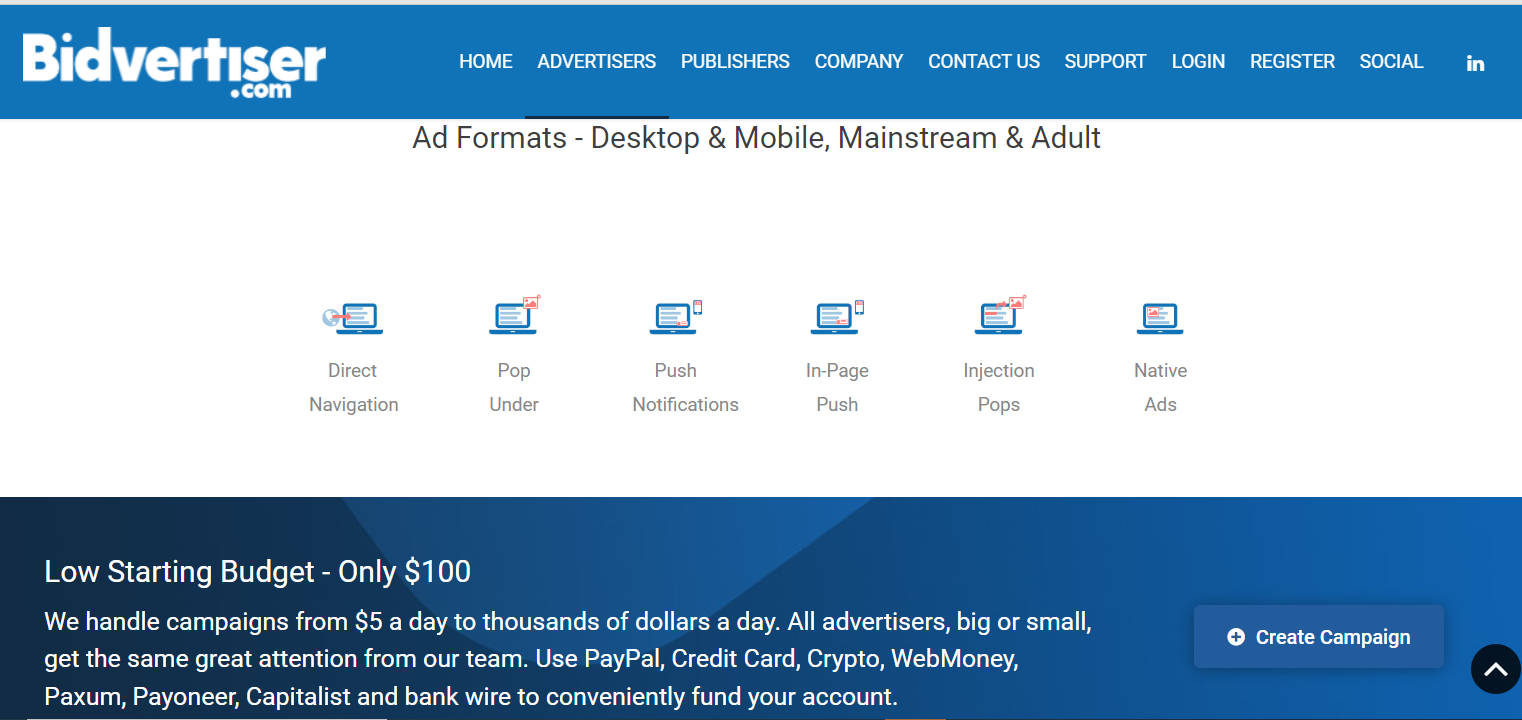
Source: Bidvertiser
Some Key Facts About BidVertiser Are:
- Rich self-serve targeting and optimization tools, powered by AI/ML
- Focus on high-quality publisher traffic and content
- No minimum monthly traffic requirements
- Websites must have quality content, regular updates, and 3+ month’s history
Benefits of BidVertiser for Publishers:
- High ad fill rates and RPMs
- Omnichannel monetization – websites, mobile apps, and more
- Payments are available via PayPal and bank transfer
Benefits of BidVertiser for Advertisers:
- Access to premium publisher inventory
- Powerful audience and contextual targeting
- AI-powered campaign optimization for better ROI
- Pay only for clicks, actions, or impressions
- Dedicated account manager support
With its robust targeting capabilities, high-performing inventory, and optimization tools, BidVertiser offers compelling monetization for publishers and effective audience reach for advertisers. The focus on premium quality traffic distinguishes BidVertiser in the ad network landscape.
6. AdPushup
Payment Model: Flexible revenue-sharing plans
Minimum Traffic: Not applicable but serve only sites that produce at least $5,000 ad revenue
AdPushup is an ad optimization platform built for publishers looking to maximize website monetization through display advertising.
- Comprehensive ad management and optimization tools
- Real-time bidding across multiple demand sources
- Advanced analytics and transparent reporting
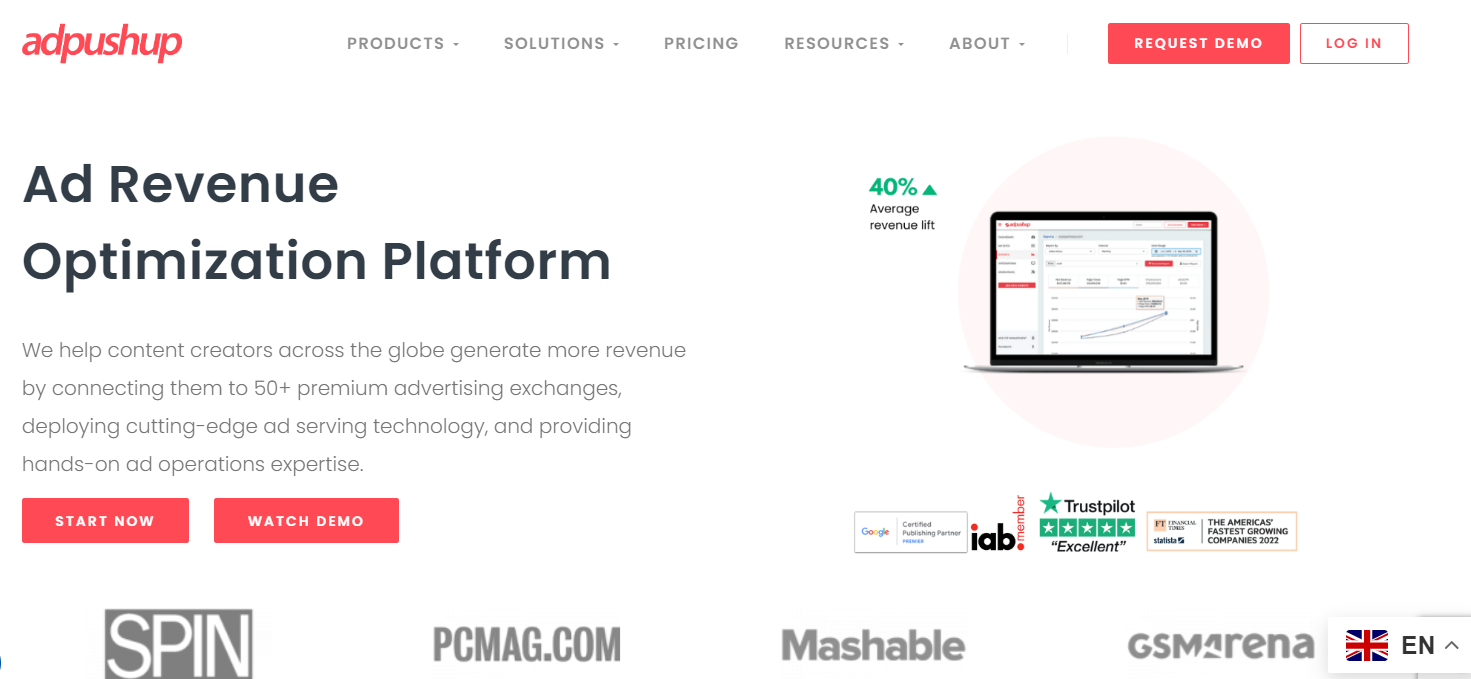
Source: AdPushup
Benefits of AdPushup for Publishers:
- Higher ad revenue through improved fill rates and CPMs
- Support for all major ad formats and placements
- Header bidding implementation for access to demand partners
- Ad layout testing and ongoing optimization
- Detailed performance analytics and actionable insights
- Dedicated ad operations team support
AdPushup Is Ideal For:
- Sites with at least $5,000/month in existing ad revenue
- Publishers focused on growing ad earnings
- Sites with engaged, high-quality traffic
AdPushup Features:
- Google AdSense and ADX integration
- Header bidding for 100% fill rates
- A/B testing capabilities
- Real-time ad analytics and revenue reporting
With its suite of revenue growth tools and managed services, AdPushup goes beyond a traditional ad network to provide specialized ad monetization and optimization for established publishers.
7. Epom
Payment Model: CPM, CPC, and CPA
Minimum Traffic: 500,000 monthly impressions
Epom is a full-stack ad network ideal for publishers and advertisers getting started with online advertising. It requires publishers to have a minimum of 500,000 monthly impressions on their websites.
- Intuitive self-serve platform and interface
- Detailed analytics and customizable reporting
- Ad campaign optimization tools
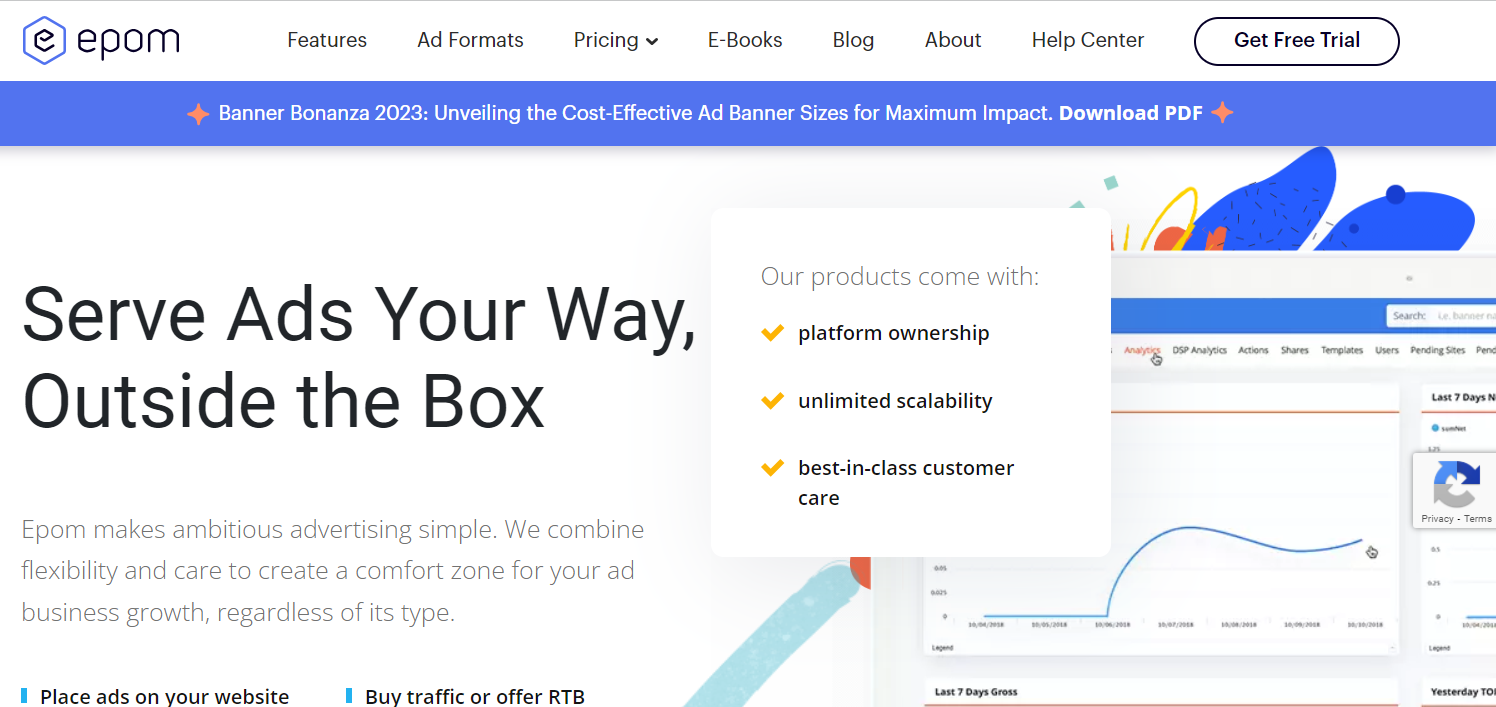
Source: Epom
Benefits of Epom for Publishers:
- Monetize website, mobile, and video inventory
- Support for 30+ rich media ad formats
- Real-time bidding to maximize revenue
- Epom Market and Epom DSP demand partners
Benefits of Epom for Advertisers:
- Access to multi-channel publisher inventory
- Targeting by device, geo, daypart, and more
- Pay only for results with CPC, CPM, and CPA models
- Free sign-up and access to all features
With its beginner-friendly workflow and extensive capabilities, Epom helps publishers monetize content while offering advertisers an intuitive way to launch and manage data-driven campaigns aimed at delivering ROI.
8. Apple Advertising
Payment Model: CPC, CPM, CPA, and CPT (Cost-per-Tap)
Minimum Traffic: Vary based on campaign type, targeting options, etc.
Apple Advertising enables brands to reach targeted audiences across iOS apps and the App Store.
- Built-in access to Apple’s huge app inventory
- Display, native, and video ad formats
- Target audiences based on their specific location, interests, and behaviors
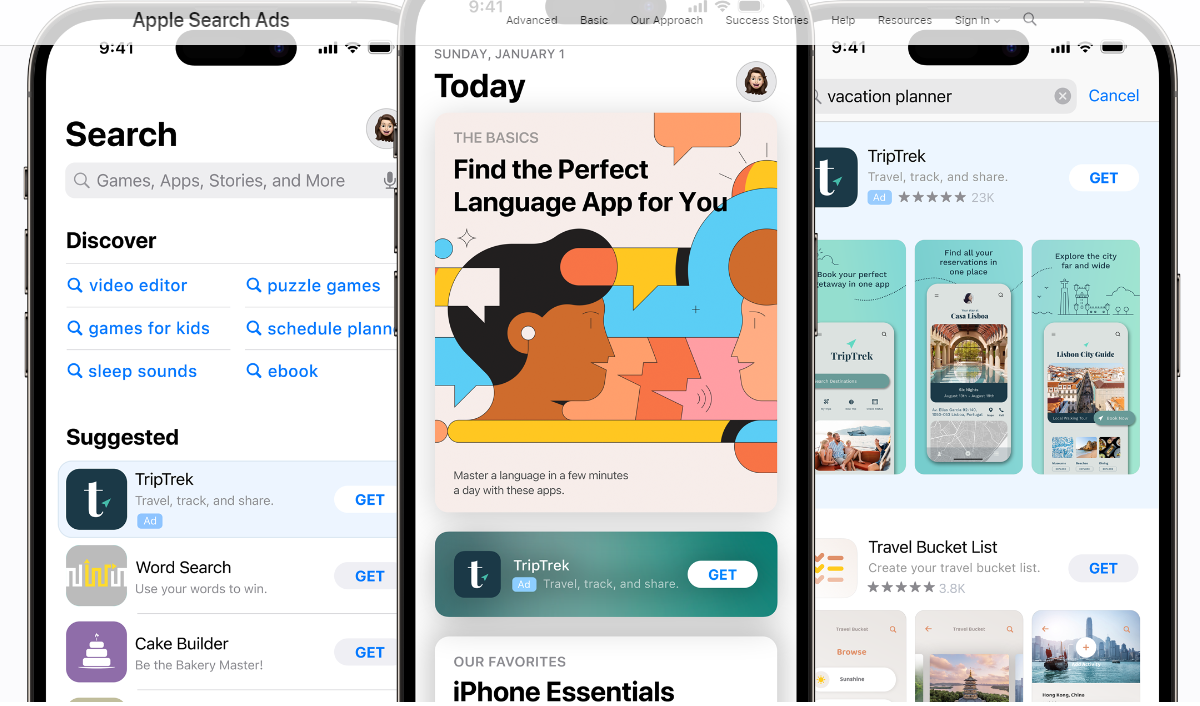
Source: Apple
Benefits for Advertisers:
- Promote apps to App Store visitors
- Drive installs and re-engagement among iOS users
- Retarget website visitors on iOS apps
- Measure performance with installs, impressions, and other metrics
- Leverage Apple’s stringent app and audience vetting
Apple’s Walled Garden:
- Ads only appear on validated apps in the App Store
- Brand safety from Apple’s strict app review policies
- Data privacy protections of Apple ecosystem
With direct mobile app promotion opportunities and access to Apple’s valuable user base, Apple Advertising provides a streamlined platform for brands to engage iOS audiences without reliance on third-party ad networks and exchanges.
9. Yahoo! Advertising
Payment Model: CPM, CPC, CPA, CPV (Cost per View), and (Cost per Engagement)
Minimum Traffic Req.: Vary
Yahoo Advertising, formerly Yahoo! Ad Manager+, offers display and native advertising solutions. Despite Yahoo’s decline as a search engine, its advertising platform still provides wide reach through popular sites like Yahoo Mail, Yahoo Sports, and more.
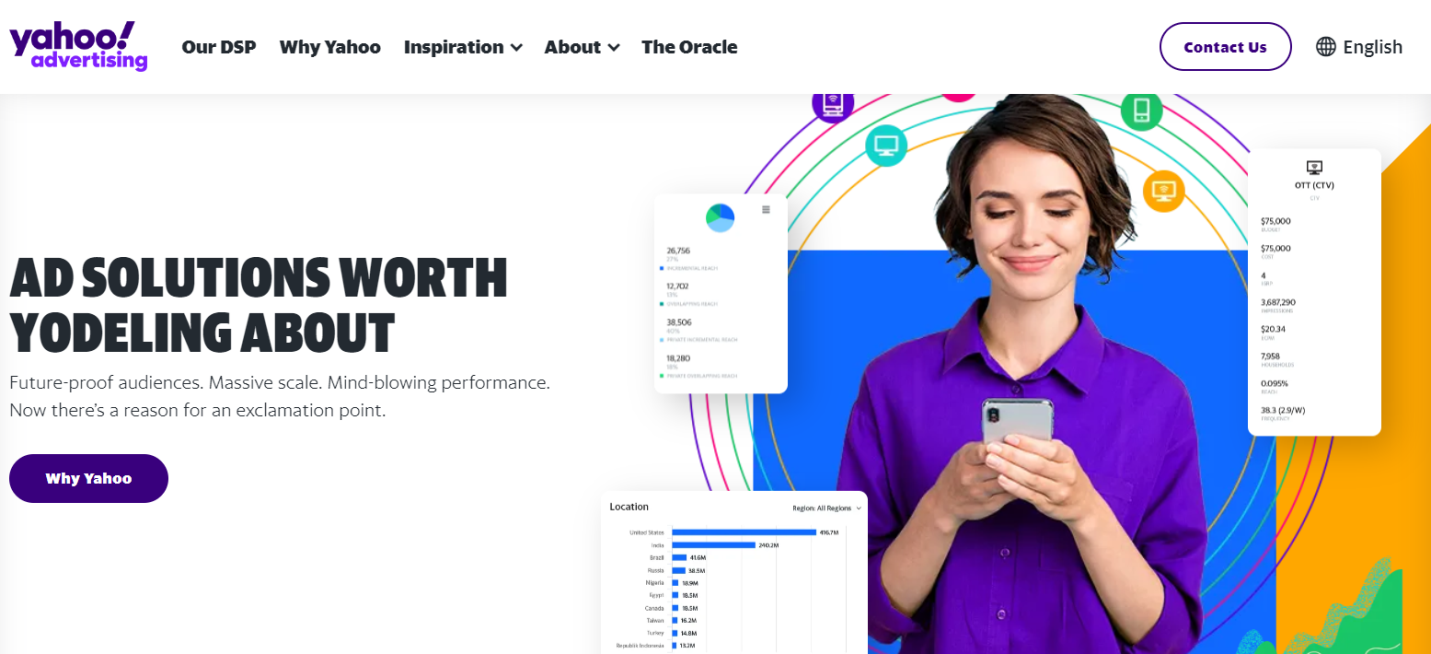
Source: Yahoo
Key Features of Yahoo! Network:
- Display, native, and video ad formats
- Powerful audience targeting capabilities
- Cross-device reach
- Brand safety controls and fraud protection
- Intuitive campaign management
- Affordable pricing options to fit small budgets
While not as dominant as Google or Facebook, Yahoo Advertising grants access to a sizable user base of hundreds of millions across its owned-and-operated sites. Yahoo remains a practical option for advertisers seeking an affordable alternative ad network.
10. Taboola
Payment Model: CPC, CPM, CPA, and CPV
Minimum Traffic: 500,000 Monthly Page Views
Though Taboola is not as widely recognized as the above display ad networks, it has an impressive base of industry-leading players to attract new advertisers every day. This platform serves ads to publications, such as The Atlantic, The Motley Fool, and even Netflix.
You also know that Netflix alone has great potential to pull advertisers, right from beginners to well-established brands.
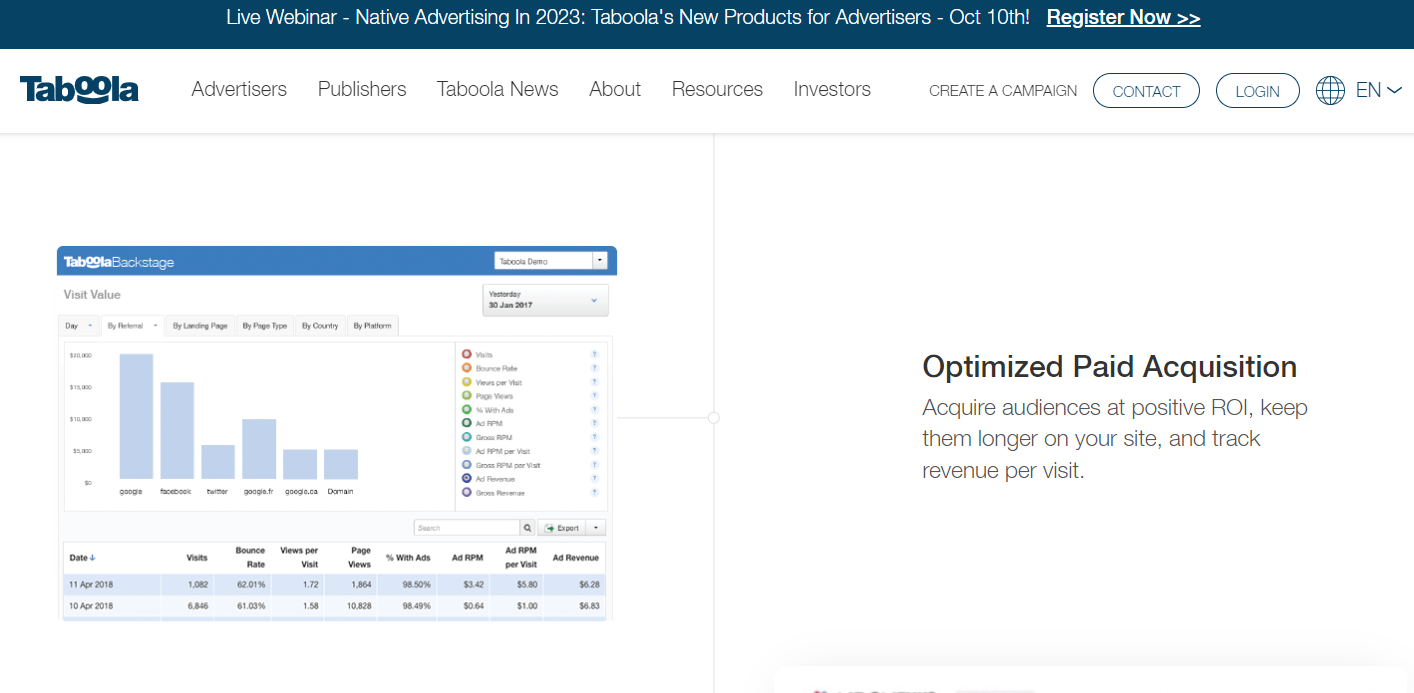
Source: Taboola
Key Features of Taboola Ad Network
- Advanced targeting options
- Variety of ad formats
- Large audience reach
Ad Formats Available on Taboola
- Display Ads
- Native Ads
- Videos Ads
- Sponsored content
The downside of Taboola is that you will be competing with brands that have high advertising budgets.
How to Evaluate the Success of Display Advertising Campaigns
Launching display ads is not enough. You also need to track the performance of display ads to further optimize them to get the best results. Here are key metrics you must track to measure the success of display advertising campaigns.
- Reach: It refers to the number of people who saw your ad, including those who clicked and who didn’t click the ad.
- Impressions: This metric shows the ad exposure or how many times your ad was displayed.
- Click-through rate (CTR): It represents the number of impressions that are actually clicked and varies from industry to industry. It is denoted by percentage and is typically less than 5%.
- Conversions: It refers to the number of people who took action intended by your ad. It could be a purchase, a call, filling out a form, booking an appointment, etc.
- Cost Per Acquisition (CPA): It shows the cost of acquiring each customer and helps determine the profitability of display advertising campaigns.
- Return on Ad Spend (ROAS): It pertains to the revenue generated by display advertising relative to ad spend.
Wrapping up
Display ads are an essential advertising tool as they help brands raise awareness, make more sales, increase website traffic, and achieve various other goals. On the other hand, Display Ad Networks provide publishers with a great way to earn money by providing ad space to advertisers. With the right display advertising knowledge and display ad network, you can make the best of the resources and tools offered by the above display ad networks. Since all display ad networks offer something unique, you must carry out due diligence about which display ad network will work best for you.
Latest posts by Vijaya Tyagi (see all)
Top 15 Best Backlink Checker Tools for SEO 2024 - October 18, 2024
Top 10 SEO Analysis Tools: A Comprehensive Comparison Guide - October 4, 2024

